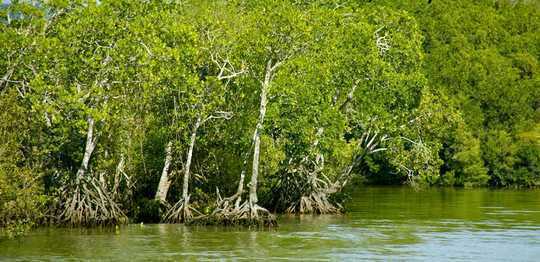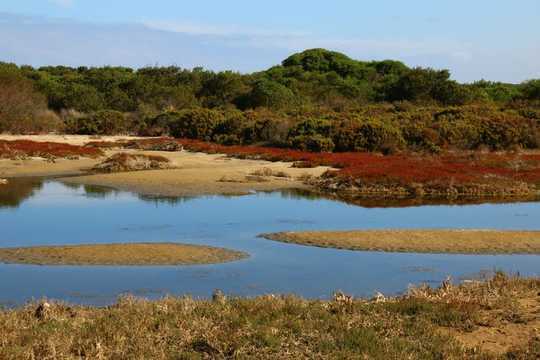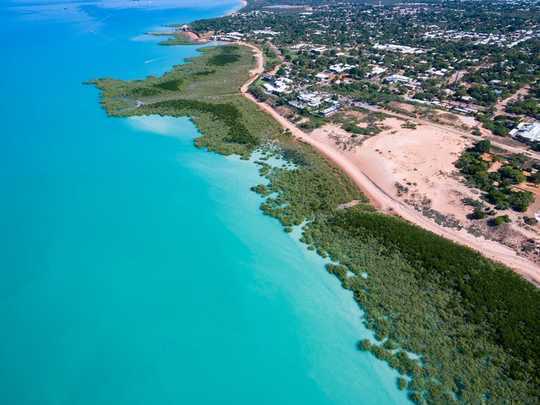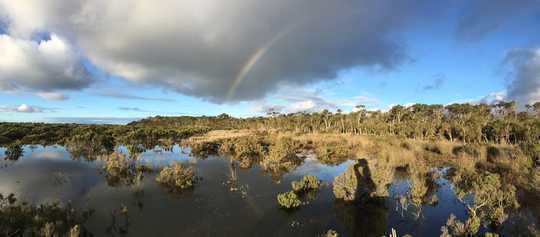
Carbon storage in Australian mangroves can help mitigate climate change. Shutterstock
Coastal wetlands don’t cover much global area but they punch well above their carbon weight by sequestering the most atmospheric carbon dioxide of all natural ecosystems.
Termed “blue carbon ecosystems” by virtue of their connection to the sea, the salty, oxygen-depleted soils in which wetlands grow are ideal for burying and storing organic carbon.
In our research, published today in Nature, we found that carbon storage by coastal wetlands is linked to sea-level rise. Our findings suggest as sea levels rise, these wetlands can help mitigate climate change.
Sea-level rise benefits coastal wetlands
We looked at how changing sea levels over the past few millennia has affected coastal wetlands (mostly mangroves and saltmarshes). We found they adapt to rising sea levels by increasing the height of their soil layers, capturing mineral sediment and accumulating dense root material. Much of this is carbon-rich material, which means rising sea levels prompt the wetlands to store even more carbon.
We investigated how saltmarshes have responded to variations in “relative sea level” over the past few millennia. (Relative sea level is the position of the water’s edge in relation to the land rather than the total volume of water within the ocean, which is called the eustatic sea level.)
What does past sea-level rise tell us?
Global variation in the rate of sea-level rise over the past 6,000 years is largely related to the proximity of coastlines to ice sheets that extended over high northern latitudes during the last glacial period, some 26,000 years ago.
As ice sheets melted, northern continents slowly adjusted elevation in relation to the ocean due to flexure of the Earth’s mantle.

Karaaf Wetlands in Victoria, Australia. Boobook48/flickr, CC BY-NC-SA
For much of North America and Europe, this has resulted in a gradual rise in relative sea level over the past few thousand years. By contrast, the southern continents of Australia, South America and Africa were less affected by glacial ice sheets, and sea-level history on these coastlines more closely reflects ocean surface “eustatic” trends, which stabilised over this period.
Our analysis of carbon stored in more than 300 saltmarshes across six continents showed that coastlines subject to consistent relative sea-level rise over the past 6,000 years had, on average, two to four times more carbon in the upper 20cm of sediment, and five to nine times more carbon in the lower 50-100cm of sediment, compared with saltmarshes on coastlines where sea level was more stable over the same period.
In other words, on coastlines where sea level is rising, organic carbon is more efficiently buried as the wetland grows and carbon is stored safely below the surface.
Give wetlands more space
We propose that the difference in saltmarsh carbon storage in wetlands of the southern hemisphere and the North Atlantic is related to “accommodation space”: the space available for a wetland to store mineral and organic sediments.
Coastal wetlands live within the upper portion of the intertidal zone, roughly between mean sea level and the upper limit of high tide.
These tidal boundaries define where coastal wetlands can store mineral and organic material. As mineral and organic material accumulates within this zone it creates layers, raising the ground of the wetlands.

The coastal wetlands of Broome, Western Australia. Shutterstock
New accommodation space for storage of carbon is therefore created when the sea is rising, as has happened on many shorelines of the North Atlantic Ocean over the past 6,000 years.
To confirm this theory we analysed changes in carbon storage within a unique wetland that has experienced rapid relative sea-level rise over the past 30 years.
When underground mine supports were removed from a coal mine under Lake Macquarie in southeastern Australia in the 1980s, the shoreline subsided a metre in a matter of months, causing a relative rise in sea level.
Following this the rate of mineral accumulation doubled, and the rate of organic accumulation increased fourfold, with much of the organic material being carbon. The result suggests that sea-level rise over the coming decades might transform our relatively low-carbon southern hemisphere marshes into carbon sequestration hot-spots.
How to help coastal wetlands
The coastlines of Africa, Australia, China and South America, where stable sea levels over the past few millennia have constrained accommodation space, contain about half of the world’s saltmarshes.

Saltmarsh on the shores of Westernport Bay in Victoria. Author provided
A doubling of carbon sequestration in these wetlands, we’ve estimated, could remove an extra 5 million tonnes of CO? from the atmosphere per year. However, this potential benefit is compromised by the ongoing clearance and reclamation of these wetlands.
Preserving coastal wetlands is critical. Some coastal areas around the world have been cut off from tides to lessen floods, but restoring this connection will promote coastal wetlands – which also reduce the effects of floods – and carbon capture, as well as increase biodiversity and fisheries production.
In some cases, planning for future wetland expansion will mean restricting coastal developments, however these decisions will provide returns in terms of avoided nuisance flooding as the sea rises.
Finally, the increased carbon storage will help mitigate climate change. Wetlands store flood water, buffer the coast from storms, cycle nutrients through the ecosystem and provided vital sea and land habitat. They are precious, and worth protecting.
About The Authors
Kerrylee Rogers, Associate Professor, University of Wollongong; Jeffrey Kelleway, Postdoctoral Research Fellow in Environmental Sciences, Macquarie University, and Neil Saintilan, Head, Department of Environmental Science, Macquarie University. The authors would like to acknowledge the contribution of their colleagues, Janine Adams, Lisa Schile-Beers and Colin Woodroffe.![]()
This article is republished from The Conversation under a Creative Commons license. Read the original article.
Related Books
Drawdown: The Most Comprehensive Plan Ever Proposed to Reverse Global Warming
by Paul Hawken and Tom Steyer In the face of widespread fear and apathy, an international coalition of researchers, professionals, and scientists have come together to offer a set of realistic and bold solutions to climate change. One hundred techniques and practices are described here—some are well known; some you may have never heard of. They range from clean energy to educating girls in lower-income countries to land use practices that pull carbon out of the air. The solutions exist, are economically viable, and communities throughout the world are currently enacting them with skill and determination. Available On Amazon
In the face of widespread fear and apathy, an international coalition of researchers, professionals, and scientists have come together to offer a set of realistic and bold solutions to climate change. One hundred techniques and practices are described here—some are well known; some you may have never heard of. They range from clean energy to educating girls in lower-income countries to land use practices that pull carbon out of the air. The solutions exist, are economically viable, and communities throughout the world are currently enacting them with skill and determination. Available On Amazon
Designing Climate Solutions: A Policy Guide for Low-Carbon Energy
by Hal Harvey, Robbie Orvis, Jeffrey Rissman With the effects of climate change already upon us, the need to cut global greenhouse gas emissions is nothing less than urgent. It’s a daunting challenge, but the technologies and strategies to meet it exist today. A small set of energy policies, designed and implemented well, can put us on the path to a low carbon future. Energy systems are large and complex, so energy policy must be focused and cost-effective. One-size-fits-all approaches simply won’t get the job done. Policymakers need a clear, comprehensive resource that outlines the energy policies that will have the biggest impact on our climate future, and describes how to design these policies well. Available On Amazon
With the effects of climate change already upon us, the need to cut global greenhouse gas emissions is nothing less than urgent. It’s a daunting challenge, but the technologies and strategies to meet it exist today. A small set of energy policies, designed and implemented well, can put us on the path to a low carbon future. Energy systems are large and complex, so energy policy must be focused and cost-effective. One-size-fits-all approaches simply won’t get the job done. Policymakers need a clear, comprehensive resource that outlines the energy policies that will have the biggest impact on our climate future, and describes how to design these policies well. Available On Amazon
This Changes Everything: Capitalism vs. The Climate
by Naomi Klein In This Changes Everything Naomi Klein argues that climate change isn’t just another issue to be neatly filed between taxes and health care. It’s an alarm that calls us to fix an economic system that is already failing us in many ways. Klein meticulously builds the case for how massively reducing our greenhouse emissions is our best chance to simultaneously reduce gaping inequalities, re-imagine our broken democracies, and rebuild our gutted local economies. She exposes the ideological desperation of the climate-change deniers, the messianic delusions of the would-be geoengineers, and the tragic defeatism of too many mainstream green initiatives. And she demonstrates precisely why the market has not—and cannot—fix the climate crisis but will instead make things worse, with ever more extreme and ecologically damaging extraction methods, accompanied by rampant disaster capitalism. Available On Amazon
In This Changes Everything Naomi Klein argues that climate change isn’t just another issue to be neatly filed between taxes and health care. It’s an alarm that calls us to fix an economic system that is already failing us in many ways. Klein meticulously builds the case for how massively reducing our greenhouse emissions is our best chance to simultaneously reduce gaping inequalities, re-imagine our broken democracies, and rebuild our gutted local economies. She exposes the ideological desperation of the climate-change deniers, the messianic delusions of the would-be geoengineers, and the tragic defeatism of too many mainstream green initiatives. And she demonstrates precisely why the market has not—and cannot—fix the climate crisis but will instead make things worse, with ever more extreme and ecologically damaging extraction methods, accompanied by rampant disaster capitalism. Available On Amazon
From The Publisher:
Purchases on Amazon go to defray the cost of bringing you InnerSelf.comelf.com, MightyNatural.com, and ClimateImpactNews.com at no cost and without advertisers that track your browsing habits. Even if you click on a link but don't buy these selected products, anything else you buy in that same visit on Amazon pays us a small commission. There is no additional cost to you, so please contribute to the effort. You can also use this link to use to Amazon at any time so you can help support our efforts.






















